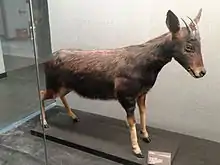Mainland serow
The mainland serow (Capricornis sumatraensis) is a serow species native to the Himalayas, Southeast Asia and China.[1][2]
| Mainland serow | |
|---|---|
 | |
| Scientific classification | |
| Kingdom: | Animalia |
| Phylum: | Chordata |
| Class: | Mammalia |
| Order: | Artiodactyla |
| Family: | Bovidae |
| Subfamily: | Caprinae |
| Genus: | Capricornis |
| Species: | C. sumatraensis[2] |
| Binomial name | |
| Capricornis sumatraensis[2] Bechstein, 1799 | |
Characteristics
The mainland serow possesses guard hairs on its coat that are bristly or coarse and cover the layer of fur closest to its skin to varying degrees. The animal has a mane that runs from the horns to the middle of the dorsal aspect of the animal between the scapulae covering the skin. The horns are only characteristic of the males and are light-colored, approximately six inches in length, and curve slightly towards the animal's back. The mainland serow is quite large and has been known to grow to be six feet long and three feet high at the shoulder, and an adult typically weighs over 150 kg.
Distribution and habitat
The mainland serow is found in central and southern China, Vietnam, Cambodia, Laos, Myanmar, and Thailand. Its distribution follows forested mountain ranges.
The mainland serow inhabits steep, rugged hills up to an elevation of 4,500 m (14,800 ft). It prefers rocky terrain but is also found in forests and flat areas. It is able to swim to small offshore islands. This species has a moderate level of tolerance to human disturbance, and could persist well in habitat fragments and secondary forests, though avoiding farmlands.
Behaviour and ecology
The mainland serow is territorial and lives alone or in small groups. It usually stays in a small area of only a few square miles where it grazes on grass, shoots and leaves from along beaten paths. It marks its territory with droppings and markings. It is most active at dawn and dusk, and spends the rest of the day in thick vegetation.
The mainland serow gives birth to a single young usually in September or October. The gestation period is about eight months.
References
- Phan, T.D.; Nijhawan, S.; Li, S. & Xiao, L. (2020). "Capricornis sumatraensis". IUCN Red List of Threatened Species. 2020: e.T162916735A162916910.
- Mori, E.; Nerva, L. & Lovari, S. (2019). "Reclassification of the serows and gorals: the end of a neverending story?". Mammal Review. 49 (3): 256–262. doi:10.1111/mam.12154.
External links
| Wikimedia Commons has media related to Capricornis sumatraensis. |
